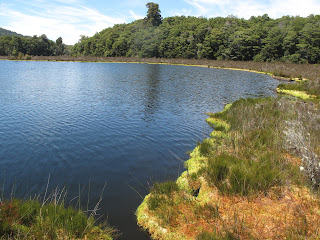The Cook Islands are a chain of 15 main islands spread out across a vast expanse of the South Pacific. Geographically the islands are about 1800 miles north-east of New Zealand and were formed by volcanic activity. The islands are self-governed but retain close ties with New Zealand and use the NZD as currency.
The main island of Rarotonga is a heavily touristed island and an especially popular destination for Kiwis and Australians. The island itself is striking, with high jungle peaks rising from the sea towards the center of the island. The main road on Rarotonga is just 32km long and circumnavigates the coast of the entire island. Off the coast a barrier reef protects the shoreline from the large waves, forming a lagoon that has good snorkeling in places.
 |
| Looking from the beach inland on Rarotonga |
 |
| Sunrise in Rarotonga |
While Rarotonga was beautiful, it lacked the remote South Pacific experience that we had envisioned, so we set off for Aitutaki, a small atoll with a breathtaking lagoon and a laid back atmosphere. Aitutaki has about 2000 inhabitants and just a few roads so we biked the entire island in just a few hours.
 |
| Flying into Aitutaki |
 |
| The vast lagoon |
Aitutaki's lagoon is famous for its expansive size and color. The lagoon is roughly an equilateral triangle with each side measuring about 12km. The average depth in the lagoon is a mere 5ft, but parts go as deep as 60ft. The shallow warm water and abundance of coral means that snorkeling is good. We went on an all day lagoon tour and were able to see some impressive fish and pristine uninhabited islands on the fringe of the reef. It was surreal being 10km from the main island but standing in water only chest deep.
 |
| A Red-Tailed Tropic Bird nesting |
 |
| A Giant Clam |
 |
| An inquisitive Giant Trevally |
 |
| A Giant Clam with neon |
 |
| Hermit Crab |
 |
| Ominous dark clouds |
On Aitutaki we stayed in a single floor house that doubled as a hostel. The owners were Cooks Islanders that had lived and raised a family in New Zealand and moved back to Aitutaki to retire. A perk of our lodging was its proximity to good local food. The cuisine in The Cook Islands is based around what is abundant: fish, tropical fruit, and root vegetables. Enormous tuna steaks with island salads and sides featuring fruits and sweet potatoes were a staple. Palm trees, star fruit, avocado, and mango trees lined most properties making otherwise exotic fruit readily available, which locals were happy to share.
 |
| Sunset at the volleyball field |
Aitutaki was really incredible. The stunning beauty of the lagoon, local hospitality, and delicious food, made the island a most memorable experience.


























































